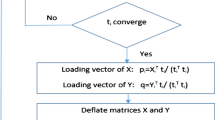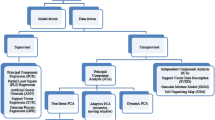Abstract
The kernel partial least squares (KPLS) method has been widely used in quality-related fault detection since it can acquire the features of the object under investigation in the detection process. However, this method has high computational requirements and storage costs. In order to address these problems, in this paper, a novel quality-related fault detection method, namely, the approximate kernel partial least squares (AKPLS) based on the truncated singular value decomposition (TSVD) has been proposed. In this method, a mapping of the process variables onto a feature space is done via AKPLS. A linear PLS is then performed on the basis of the TSVD in the feature space, owing to which the proposed AKPLS method can be scaled to approximate the kernel matrix with limited memory storage. Therefore, the proposed AKPLS method can be used for handling real-time quality-related fault detection and large-scale quality-related detection. The RMSEP obtained by the AKPLS model was significantly smaller than that obtained by the eLW-KPLS and LW-KPLS models. As the number of samples increases, the RMSEP of AKPLS is observed to become smaller and gradually tends to a constant value. Therefore, the proposed AKPLS is observed to be well suited for a mass-dependent prediction model. The AKPLS model achieved a larger R2 compared to the PLS, KPLS, eLW-KPLS and LW-KPLS models. The relatively large coefficient of determination R2 indicates that the variables selected by the AKPLS model have a strong influence on the predicted values. The statistics of the root mean squared error (RMSE) and the determination coefficients R2 have been constructed in order to monitor the quality-related fault detection. The effectiveness of the proposed method has been illustrated using a numerical example and the penicillin fermentation process.
Similar content being viewed by others
Data Availability
The experimental data used to support the findings of this study are available from the corresponding author upon request.
References
Ge, Z.: Review on data-driven modeling and monitoring for plant-wide industrial processes. Chemom. Intell. Lab. Syst. 171, 16–25 (2017). https://doi.org/10.1016/j.chemolab.2017.09.021
Yin, S., Ding, S.X., Xie, X., Luo, H.: A review on basic data-driven approaches for industrial process monitoring. IEEE Trans. Industr. Electron. 61(11), 6418–6428 (2014). https://doi.org/10.1109/TIE.2014.2301773
Jiang, Q., Wang, Y., Yan, X.: Optimal variable transmission for distributed local fault detection incorporating RA and evolutionary optimization. IEEE Access 6, 3201–3211 (2018). https://doi.org/10.1109/ACCESS.2017.2787620
Wold, S., Kettaneh-Wold, N., Skagerberg, B.: Non-linear PLS modeling. Chemom. Intell. Lab. Syst. 7, 53–65 (1989). https://doi.org/10.1016/0169-7439(89)80111-X
Rosipal, R., Trejo, L.J.: Kernel partial least squares regression in reproducing kernel Hillbert space. J. Mach. Learn. Res. 2, 97–123 (2001). https://doi.org/10.1162/15324430260185556
Lin, S., Zhou, D.: Optimal learning rates for kernel partial least squares. J. Fourier Anal. Appl. 24(3), 908–933 (2017). https://doi.org/10.1007/s00041-017-9544-8
Kim, S., Kano, M., Nakagawa, H., Hasebe, S.: Estimation of active pharmaceutical ingredients content using locally weighted partial least squares and statistical wavelength selection. Int. J. Pharm. 421(2), 269–274 (2011). https://doi.org/10.1016/j.ijpharm.2011.10.007
Zhang, X., Yan, W., Shao, H.: Non-linear multivariate quality estimation and prediction based on kernel partial least squares. Ind. Eng. Chem. Res. 47(4), 1120–1131 (2008). https://doi.org/10.1021/ie070741+
Zhang, Y., Teng, Y., Zhang, Y.: Complex process quality prediction using modified kernel partial least squares. Chem. Eng. Sci. 65(6), 2153–2158 (2010). https://doi.org/10.1016/j.ces.2009.12.010
Peng, K., Zhang, K., Li, G.: Quality-related process monitoring based on total kernel PLS model and its industrial application. Math. Probl. Eng. 2013, 1–14 (2013). https://doi.org/10.1155/2013/707953
Jia, Q., Zhang, Y.: Quality-related fault detection approach based on dynamic kernel partial least squares. Chem. Eng. Res. Des. 106, 242–252 (2016). https://doi.org/10.1016/j.cherd.2015.12.015
Zhang, X., Kano, M., Li, Y.: Locally weighted kernel partial least squares regression based on sparse non-linear features for virtual sensing of non-linear time-varying processes. Comput. Chem. Eng. 104, 164–171 (2017). https://doi.org/10.1016/j.compchemeng.2017.04.014
Zhou, P., Zhang, R., Liang, M., Fu, J., Wang, H., Chai, T.: Fault identification for quality monitoring of molten iron in blast furnace ironmaking based on KPLS with improved contribution rate. Control Eng. Pract. 97 (2020). https://doi.org/10.1016/j.conengprac.2020.104354
Jiao, J., Zhao, N., Wang, G., Yin, S.: A non-linear quality-related fault detection approach based on modified kernel partial least squares. ISA Trans. 66, 275–283 (2017). https://doi.org/10.1016/j.isatra.2016.10.015
Smola, A.J., Schölkopf, B.: Sparse greedy matrix approximation for machine learning. International Conference on Machine Learning, pp.911–918 (2000)
Savas, B., Dhillon, I.S.: Clustered matrix approximation. SIAM J. Matrix Anal. Appl. 37(4), 1531–1555 (2016). https://doi.org/10.1137/15M1042206
Lee, J., Kim, S., Lebanon, G., Singer, Y., Bengio, S.: LLORMA: Local low-rank matrix approximation. J. Mach. Learn. Res. 17(1), 442–465 (2016)
Parekh, A., Selesnick, I.W.: Enhanced low-rank matrix approximation. IEEE Signal Process. Lett. 23(4), 493–497 (2016). https://doi.org/10.1109/lsp.2016.2535227
Ding, L., Liao, S., Liu, Y., Liu, L., Gao, X.: Approximate kernel selection via matrix approximation. IEEE Transactions on Neural Networks and Learning Systems, PP(99), pp.1–11 (2020). https://doi.org/10.1109/TNNLS.2019.2958922
Zheng, J., Qin, M., Zhou, X., Mao, J., Yu, H.: Efficient implementation of truncated reweighting low-rank matrix approximation. IEEE Trans. Industr. Inf. 16(1), 488–500 (2020). https://doi.org/10.1109/TII.2019.2916986
Troppy, J.A., Yurtseverz, A., Udellx, M., Cevher, V.: Practical sketching algorithms for low-rank matrix approximation. SIAM J. Matrix Anal. Appl. 38(4), 1454–1485 (2017). https://doi.org/10.1137/17M1111590
Drineas, P., Ipsen, I.C.F.: Low-rank matrix approximations do not need a singular value gap. SIAM J. Matrix Anal. Appl. 40(1), 299–319 (2019). https://doi.org/10.1137/18M1163658
Hansen, P.C.: Truncated singular value decomposition solutions to discrete ill-posed problems with ill-determined numerical rank. SIAM J. Sci. Stat. Comput. 11(3), 503–518 (1990)
Boutsidis, C., Magdon-Ismail, M.: Faster SVD-truncated gegularized least-squares. 2014 IEEE International Symposium on Information Theory (ISIT) (2014). https://doi.org/10.1109/ISIT.2014.6875047.
Ebadi, M.J., Fahs, A., Fahs, H., Dehghani, R.: Competitive secant (BFGS) methods based on modified secant relations for unconstrained optimization. Optimization (2022). https://doi.org/10.1080/02331934.2022.2048381
Schölkopf, B., Smola, A.J.: Learning with kernels: support vector machines, regularization, optimization, and beyond. MIT Press, Cambridge (2002)
Golub, G.H., Heath, M., Wahba, G.: Generalized cross-validation as a method for choosing a good ridge parameter. Technometrics 21(2), 215–223 (1979). https://doi.org/10.1080/00401706.1979.10489751
Birol, G., Ündey, C., Cinar, A.: A modular simulation package for fed-batch fermentation: penicillin production. Comput. Chem. Eng. 26(11), 1553–1565 (2002). https://doi.org/10.1016/S0098-1354(02)00127-8
Zhao, B., Shi, H., Song, B., Tan, S.: Quality weakly related fault detection based on weighted dual-step feature extraction. IEEE Access 7, 7860–7871 (2019). https://doi.org/10.1109/ACCESS.2018.2890301
Yang, C., Hou, J.: Fed-Batch Fermentation Penicillin Process fault diagnosis and detection based on support vector machine. Neurocomputing (2016). https://doi.org/10.1016/j.neucom.2016.01.027
Wold, H.: Path models with latent variables: the NIPALS approach. Quantitative Sociology: International Perspectives on Mathematical and Statistical Modeling. 307–357 (1975). https://doi.org/10.1016/B978-0-12-103950-9.50017-4.
Acknowledgements
The authors would like to thank the anonymous reviewers and editors for their valuable suggestions that greatly improved the quality of this presentation.
Funding
This work was sponsored in part by the National Natural Science Foundation of China (61772020).
Author information
Authors and Affiliations
Contributions
The experimental data used to support the findings of this study are available from the corresponding author upon request.
Corresponding author
Ethics declarations
Competing Interests
The authors declare no competing interests.
Conflicts of Interest
The authors declared that they have no conflicts of interest regarding this work.
Additional information
Publisher's Note
Springer Nature remains neutral with regard to jurisdictional claims in published maps and institutional affiliations.
Rights and permissions
Springer Nature or its licensor (e.g. a society or other partner) holds exclusive rights to this article under a publishing agreement with the author(s) or other rightsholder(s); author self-archiving of the accepted manuscript version of this article is solely governed by the terms of such publishing agreement and applicable law.
About this article
Cite this article
Liu, X., Zhou, S. Quality-related Fault Detection Based on Approximate Kernel Partial Least Squares Method. J Grid Computing 21, 29 (2023). https://doi.org/10.1007/s10723-023-09670-1
Received:
Accepted:
Published:
DOI: https://doi.org/10.1007/s10723-023-09670-1




